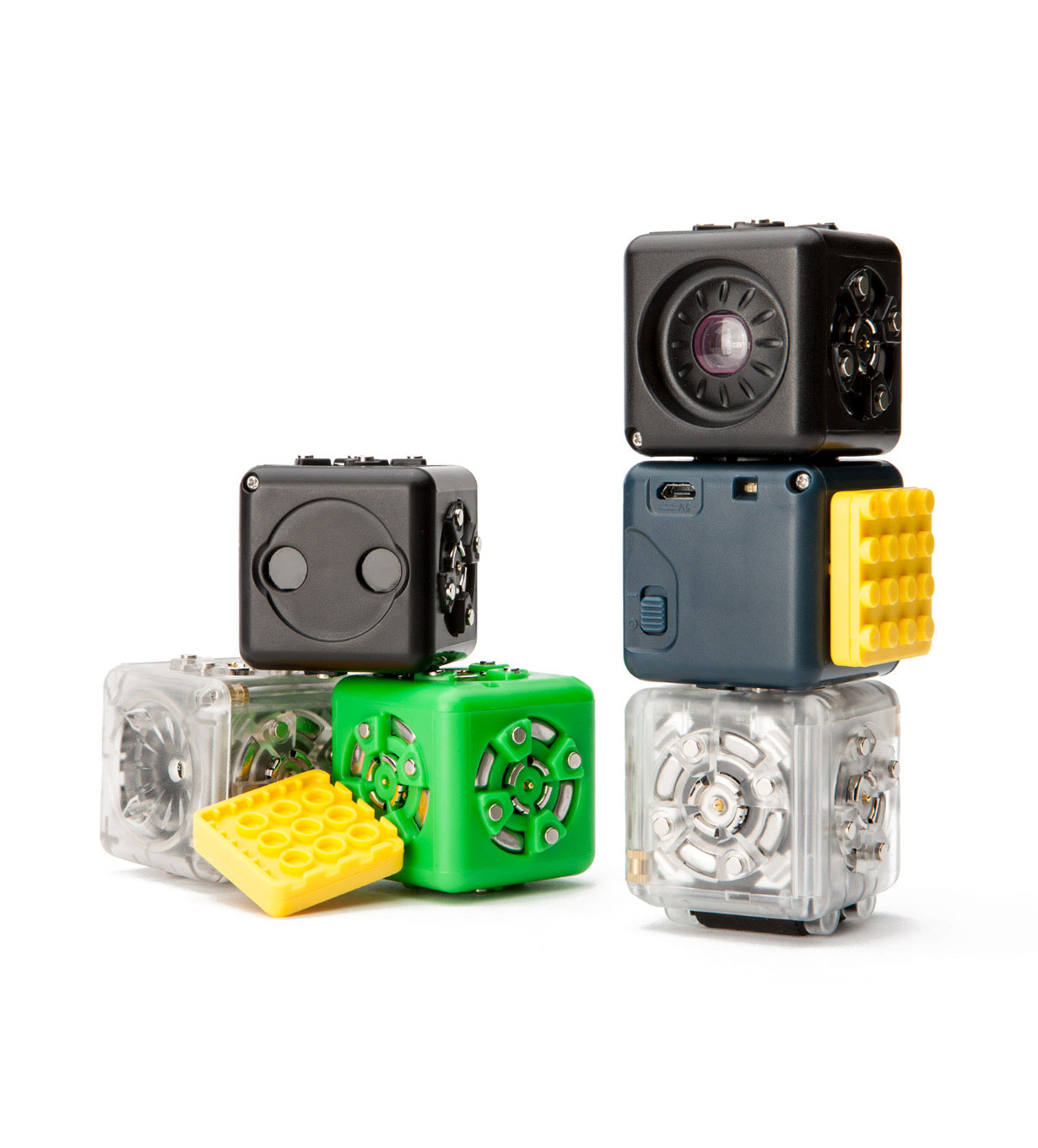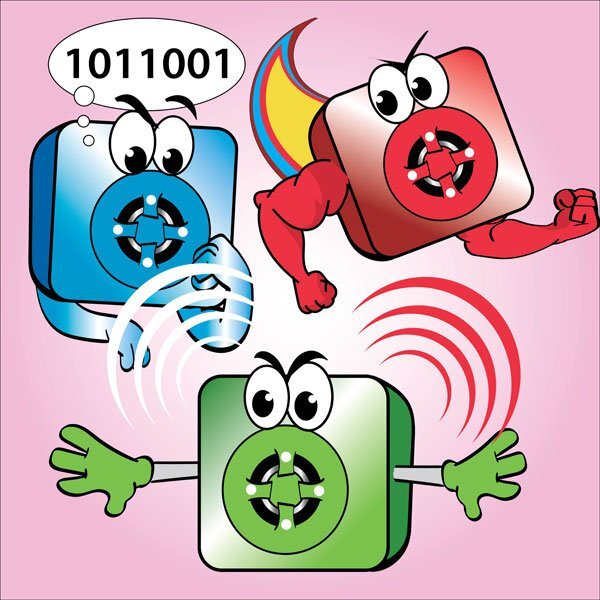Lesson Modules
Teaching Tips:
KT06 and Additional Think Cubelets in the Classroom, 40 minutes activity
This is a continuation of students constructing robots using Cubelets. By snapping together magnetic blocks that represent the Sense and Act Cubelets in different configurations students can explore the input‐output relationship robots use to react to their environment. In this activity, students explore the think component of robots using Think Cubelets to manipulate information passing between senses and actions.
For each class/group, this lesson plan includes 2 parts:
Each segment is suggested to last 20 minutes in order to comprise one class of about 40 minutes.
- A hands-on exploration of the e Think function of a robot
- An extended robotics challenge
Each segment is suggested to last for 20 minutes, with two segments comprising a 40-minute class.
These lesson plans have suggested age levels, but it is possible to use the younger grade activities as a ramp up to older grades; e.g. use the 6 years old ‐ 9 years old activities to ramp up and extend a lesson plan for a group of 10‐12 year olds. Similarly, the activities suggested for older students can become a way to expand on challenges presented to younger learners if there are time and interest.
Re‐introduce students to the basics of robotics ‐ robots sense, think and act
Q: What did we said about what robots do in the last class? Robots do three things - can you name them?
A: Robots sense, think, and act.
Q: Can you think of robots in movies or TV? What are their inputs and outputs (senses and reactions) they might be using?

Teaching Tips:
Materials: KT06 kits with Passive Cubes included, as well as Blocker, and Inverse Cubelets groups of 14 students using each kit.
A hands‐on opportunity for students to understand how the Think component of a robot changes information sent from the sense to the act component.
/IMG_1385.jpg)
Tell the class: “In the last class we used Sense Cubelets and Action Cubelets to build robots that drove and lit up. Today we’re going to make our robots a little smarter by using Think Cubelets with the senses and actions. Let’s see how this changes our robots.”
Suggested age variations/progression:
- 6 years old to 9 years old: Use the Battery, Brightness, Passive and Flashlight. “We built this robot before, but without the green Think Cubelet. Test out this Think component by putting it between the sense and the action ‐ what do you think this Cube is doing to the information going from the Brightness sense to the Flashlight Action? Is getting the light to be brighter or dimmer any different? Has this Think component changed how information goes from this sense to this action ‐ when does the light get bright? When there’s a lot of light on the black Brightness sense or a little light? What does that mean?”
- 9 years old to 12 years old (designed for this module): With the Battery, Brightness, Passive and Flashlight Cubelets tell students, “I’m passing out a Think Cubelet that sees information from the Sense Cubelet and then does work on that information before it goes to the Act Cubelet. Can you build robots with this Think Cubelet and test out what it does? Has this Think component changed the sense information going to the action ‐ when does the light get brighter or dimmer? What does that mean?” Swap the Passive for the Inverse Cubelet. ‐ students should use the Brightness and Flashlight Cubelet with the Inverse but as they form theories about what “Think” function the Inverse Cubelet is doing, have them swap senses and swap actions one at a time to further test their theory. Students can practice using these two Think Cubelets by swapping senses and swapping actions.
- 12 years old and up (designed for this module): When students have mastered and understood the Passive and Inverse Think Blocks, have them use the Blocker Cubelet by directing them to use both small sense‐action Cubelet combinations on each side of this new Think cube. “How is this Think cube combining these smaller robots to make a bigger robot? How is it different than putting the Passive Think Cubelet here?”
/IMG_1387.jpg)
/IMG_1390.jpg)
/IMG_1391.jpg)
Materials: KT06 kits with Passive Cubes included, as well as Blocker, and Inverse Cubelets.
A hands‐on opportunity to understand how the Think component of a robot changes information sent from the sense to the act component.
/IMG_1385.jpg)
In the last class, we used Sense Cubelets and Action Cubelets to build robots that drove and lit up. Today we’re going to make our robots a little smarter by using Think Cubelets with the senses and actions. Let’s see how this changes our robots.
With the Battery, Brightness, Passive and Flashlight Cubelets your teacher will be passing out a Think Cubelet that sees information from the Sense Cubelet and then does work on that information before it goes to the Act Cubelet.
- Can you build robots with this Think Cubelet and test out what it does?
- Has this Think component changed the sense information going to the action?
- When does the light get brighter or dimmer?
- What does that mean?
Swap the Passive for the Inverse Cubelet. ‐ you should use the Brightness and Flashlight Cubelet with the Inverse but as you form theories about what “Think” function the Inverse Cubelet is doing, swap senses and swap actions one at a time to further test your theory. You can practice using these two Think Cubelets by swapping senses and swapping actions.
When you have mastered and understood the Passive and Inverse Think Blocks, use the Blocker Cubelet to use both small sense‐action Cubelet combinations on each side of this new Think cube.
- How is this Think cube combining these smaller robots to make a bigger robot?
- How is it different than putting the Passive Think Cubelet here?
/IMG_1387.jpg)
/IMG_1390.jpg)
/IMG_1391.jpg)
Teaching Tips:
An extended robotics challenge
Materials: KT06 kits, groups of 14 students using each kit as well as use of the additional Think Cubelets.
This is an opportunity for students to design their own robot using the Think components of robotics. Students get to test their understanding of the Sense, Think, and Act components of a robot by creating their own challenges and proposing designs to meet them.

Suggested age variations/progression:
- 6 years old to 9 years old: Using the 6 cubes in your box, what is the coolest robot you can make? What does it do? Can it be used for anything“
- 9 years old to 12 years old: Plan a robot with 2 senses and 2 actions and 1 Think Cube (inverse, blocker, or passive) engineer, design and build it with a purpose for how it would be used in mind. Test it and see if it will meet that purpose and make design changes if need be.
- 12 years old and up (designed for this module): “Can you pick one Think Cubelet, one action and one sense and make a robot that you can steer across the table and then turn a corner? If your robot doesn’t work right away, keep planning, building, and then testing it to get it right. Now add two senses and two actions ‐ how does this change the design. Think about what the robot has to sense and what inputs it will need.”
/IMG_1393.jpg)
/IMG_1396.jpg)
Materials: KT06 kits.
This is an opportunity to design their own robot using the Think components of robotics. You will get to test your understanding of the Sense, Think, and Act components of a robot by creating your own challenges and proposing designs to meet them.

/IMG_1393.jpg)
/IMG_1396.jpg)
Teaching Tips:

